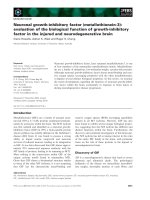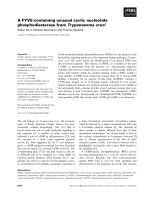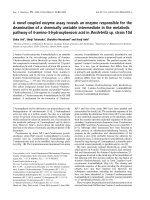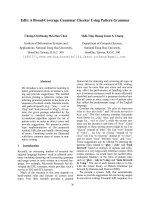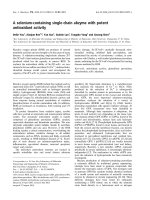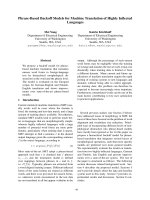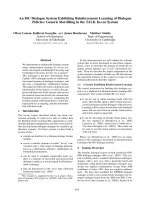Báo cáo khoa học: "A Natriuretic peptide testing for the evaluation of critically ill patients with shock in the intensive care unit: a prospective cohort study" pptx
Bạn đang xem bản rút gọn của tài liệu. Xem và tải ngay bản đầy đủ của tài liệu tại đây (270.12 KB, 7 trang )
Open Access
Available online />Page 1 of 7
(page number not for citation purposes)
Vol 10 No 1
Research
Natriuretic peptide testing for the evaluation of critically ill
patients with shock in the intensive care unit: a prospective cohort
study
James L Januzzi
1
, Alexander Morss
2
, Roderick Tung
2
, Richard Pino
3
, Michael A Fifer
1
, B
Taylor Thompson
4
and Elizabeth Lee-Lewandrowski
5
1
Division of Cardiology*, Massachusetts General Hospital, Boston, Massachusetts, USA
2
Department of Medicine†, Massachusetts General Hospital, Boston, Massachusetts, USA
3
Department of Anesthesia and Critical Care‡, Massachusetts General Hospital, Boston, Massachusetts, USA
4
Department of Pulmonary/Critical Care, Massachusetts General Hospital, Boston, Massachusetts, USA
5
Department of Laboratory Medicine, Massachusetts General Hospital, Boston, Massachusetts, USA
Corresponding author: James L Januzzi,
Received: 10 Nov 2005 Revisions requested: 16 Jan 2006 Revisions received: 19 Jan 2006 Accepted: 3 Feb 2006 Published: 22 Feb 2006
Critical Care 2006, 10:R37 (doi:10.1186/cc4839)
This article is online at: />© 2006 Januzzi et al.; licensee BioMed Central Ltd.
This is an open access article distributed under the terms of the Creative Commons Attribution License ( />),
which permits unrestricted use, distribution, and reproduction in any medium, provided the original work is properly cited.
Abstract
Introduction Amino-terminal pro-brain natriuretic peptide (NT-
proBNP) is useful in evaluating heart failure, but its role in
evaluating patients with shock in the intensive care unit (ICU) is
not clear.
Method Forty-nine consecutive patients in four different ICUs
with shock of various types and with an indication for pulmonary
artery catheter placement were evaluated. Analyses for NT-
proBNP were performed on blood obtained at the time of
catheter placement and results were correlated with pulmonary
artery catheter findings. Logistic regression identified
independent predictors of mortality.
Results A wide range of NT-proBNP levels were observed (106
to >35,000 pg/ml). There was no difference in median NT-
proBNP levels between patients with a cardiac and those with a
noncardiac origin to their shock (3,046 pg/ml versus 2,959 pg/
ml; P = 0.80), but an NT-proBNP value below 1,200 pg/ml had
a negative predictive value of 92% for cardiogenic shock. NT-
proBNP levels did not correlate with filling pressures or
hemodynamics (findings not significant). NT-proBNP
concentrations were higher in patients who died in the ICU
(11,859 versus 2,534 pg/ml; P = 0.03), and the mortality rate of
patients in the highest log-quartile of NT-proBNP (66.7%) was
significantly higher than those in other log-quartiles (P < 0.001);
NT-proBNP independently predicted ICU mortality (odds ratio
14.8, 95% confidence interval 1.8–125.2; P = 0.013), and was
superior to Acute Physiology and Chronic Health Evaluation II
score and brain natriuretic peptide in this regard.
Conclusion Elevated levels of NT-proBNP do not necessarily
correlate with high filling pressures among patients with ICU
shock, but marked elevation in NT-proBNP is strongly
associated with ICU death. Low NT-proBNP values in patients
with ICU shock identifed those at lower risk for death, and may
be useful in excluding the need for pulmonary artery catheter
placement in such patients.
Introduction
Patients with shock in the intensive care unit (ICU) setting are
at high risk for morbidity and mortality, and optimal strategies
to evaluate and manage ICU patients with shock are needed.
One method to evaluate patients with ICU shock includes
invasive hemodynamic monitoring with pulmonary artery cath-
eter (PAC) placement. Such invasive monitoring, although
widely employed, has been shown to be associated only
equivocally with improved outcomes in the ICU setting [1] and,
in fact, it may be associated with a null effect on outcomes [2-
4] or with increased hazard in certain individuals [1,5]. Accord-
ingly, a noninvasive method for estimating cardiac filling pres-
sures and hemodynamics in ICU patients with shock would be
desirable.
APACHE = Acute Physiology and Chronic Health Evaluation; BNP = brain natriuretic peptide; ICU = intensive care unit; NT-proBNP = amino-terminal
pro-brain natriuretic peptide; PAC = pulmonary artery catheter; PCWP = pulmonary capillary wedge pressure.
Critical Care Vol 10 No 1 Januzzi et al.
Page 2 of 7
(page number not for citation purposes)
Biomarker measurement has been used in the optimal evalua-
tion and management of multiple disease states, ranging from
endocrinologic states such as diabetes or thyroid diseases to
cardiovascular diseases such as acute coronary syndromes
and heart failure. However, the role of biomarkers in the evalu-
ation of patients in the ICU setting remains largely unexplored.
Because hemodynamic monitoring is a frequent theme in the
evaluation of patients in the ICU setting, there may be logic
behind evaluating ICU patients by testing for B-type (brain)
natriuretic peptide (BNP) or its amino-terminal pro-fragment
NT-proBNP. These markers are useful in diagnosing or exclud-
ing heart failure [6,7] as well as in estimating prognosis [8] and
for managing patients with heart failure [9]. In patients with rel-
atively uncomplicated heart failure, concentrations of natriu-
retic peptides correlate to a degree with cardiac filling
pressures and hemodynamics, particularly within the same
individual [10,11]. The implication is that measurement of
natriuretic peptides might be useful in that they may allow inva-
sive monitoring to be avoided in some patients with heart fail-
ure.
Given their value in evaluating and managing patients with
heart failure, the natriuretic peptide class of biomarkers might
be useful as a surrogate for PAC placement in patients with
undefined hemodynamics, in whom PAC placement might oth-
erwise be contemplated. In ICU patients with undifferentiated
shock, we recently demonstrated that BNP concentrations are
frequently elevated but unrelated to cardiac filling pressures or
hemodynamics [12]. Despite the lack of association between
BNP and cardiac parameters, BNP strongly predicted ICU
mortality. Less is known about NT-proBNP levels in ICU shock
patients [13] and whether any additive information might be
gained from using NT-proBNP rather than BNP. Accordingly,
we performed the present analysis to evaluate the behavior of
NT-proBNP in patients with shock in the ICU, to examine the
relationship between NT-proBNP and cardiac hemodynamics/
filling pressures, to evaluate the utility of NT-proBNP to predict
ICU death in patients with shock, and to examine the role of
NT-proBNP with other biomarkers in estimating prognosis in
the ICU.
Materials and methods
Study design
This study was approved by the institutional review board and
was conducted in the surgical, cardiac, and medical ICUs at
the Massachusetts General Hospital. The design of the pred-
ecessor BNP study was previously reported [12]. The present
study examined patients from the same cohort, with two
patients in the previous data set removed because of lack of
NT-proBNP data and two patients without BNP data in the
prior analysis added, leaving the same number of patients for
the present analysis. In brief, the 49 patients were prospec-
tively enrolled. They met both of the following inclusion criteria:
hypotension, defined as a systolic blood pressure below 100
mmHg with end-organ dysfunction or need for vasopressor or
inotropic agents (including norepinephrine [noradrenaline],
phenylephrine, vasopressin, dopamine, dobutamine, or milri-
none); and intention by the clinicians managing the patient to
place a PAC for diagnosis or monitoring as part of standard
care.
For each patient, 5 ml blood was collected into a tube contain-
ing EDTA at the time of PAC placement. Samples were proc-
essed and analyzed for BNP concentrations (Triage; Biosite,
LaJolla, CA, USA). Following the original study, frozen samples
from each patient were thawed and NT-proBNP concentra-
tions were measured using a commercially available immu-
noassay (Elecsys proBNP; Roche Diagnostics, Indianapolis,
IN, USA). The patients, researchers and ICU physicians were
blinded to natriuretic peptide findings.
Clinical characteristics, including demographics, past medical
history, presenting syndrome, PAC variables (including filling
pressures and hemodynamics), and subsequent hospital
course, were recorded.
Cardiac hemodynamics (including cardiac index) were calcu-
lated using the thermodilution technique and pulmonary capil-
lary wedge pressures (PCWPs) were measured at end
expiration. Acute Physiology and Chronic Health Evaluation
(APACHE) II scores were calculated using data available from
the 24-hour period at the time of enrollment.
Patients were classified on a binary system as having shock of
cardiac or noncardiac origin. The former group ('cardiac ori-
gin') included patients with symptoms/signs of shock follow-
ing an acute myocardial infarction with or without acute
destabilized heart failure. In addition, we further considered a
subgroup of patients within the category of 'cardiac origin' of
shock, namely those with cardiogenic shock, defined as hav-
ing suffered a cardiac event associated with the combination
of both cardiac index below 2.2 l/min per m
2
and PCWP above
18 mmHg. The 'noncardiac' group included those with distrib-
utive, hypovolemic, and mixed shock etiologies.
The primary end-points for this study were similar to those in
the original report [12], with substitution of NT-proBNP levels
for BNP levels for correlation with PCWP and cardiac index.
An analysis to determine the negative predictive value of NT-
proBNP in order to rule out cardiogenic shock was performed,
and the utility of NT-proBNP in predicting ICU death was
examined, including a comparison of NT-proBNP results with
the results of BNP testing as well as with APACHE II scoring
[14].
Statistical analysis
NT-proBNP levels were log-transformed to achieve normality.
Correlations between NT-proBNP values and PCWP and
between NT-proBNP values and cardiac index were per-
formed by bivariate analyses with Spearman correlation. Com-
Available online />Page 3 of 7
(page number not for citation purposes)
parisons of median NT-proBNP levels between survivors and
those who died were made by nonparametric testing.
In order to analyze the prognostic influence of NT-proBNP in
the ICU, receiver operating characteristic analyses for death
as a function of NT-proBNP concentration were performed,
using Analyze-it software (Analyze-it, Leeds, UK). Patients
were categorized into quartiles using log-transformed NT-
proBNP values. Multivariable analysis utilizing stepwise logis-
tic regression was used to identify independent predictors of
death. Factors included in the multivariable model included
age, sex, diagnosis of cardiogenic shock, use of mechanical
ventilation, cardiac troponin T concentration, renal function as
indicated by serum creatinine, blood pH, BNP concentration,
and APACHE II score. Logistic regression analysis used step-
ping with verification of goodness-of-fit with the Hosmer-
Lemeshow test. Odds ratios were generated and expressed
with 95% confidence intervals. All P values are two-sided, and
P < 0.05 was considered statistically significant. All statistical
analyses were performed using SPSS software (SPSS Insti-
tute Inc., Chicago, IL, USA).
Results
The baseline characteristics of the study group are shown in
Table 1. Approximately half of the patients had shock of car-
diac origin, whereas the remaining patients had shock of dif-
ferent etiologies. Seven patients had cardiogenic shock, as
defined above.
NT-proBNP levels and hemodynamics
The median (interquartile range) NT-proBNP for all patients
was 3,046 (1,074–16,068) pg/ml; a wide range of NT-
proBNP values was documented (106 to >35,000 pg/ml).
Table 1
Baseline characteristics of the study population
Characteristic Value
Age (years) 67.8 ± 13.8
Male sex 69%
Prior heart failure 47%
APACHE II score 21.8 ± 6.9
Hemodynamics
Cardiac index (l/min per m
2
)3.1 ± 1.4
PCWP (mmHg) 19.2 ± 7.1
Shock origin
Cardiac
a
57%
Septic/SIRS 43%
Mechanical ventilation 78%
Serum creatinine (mg/dl) 1.80 (1.05–2.25)
Cardiac troponin T (ng/ml) 0.19 (0.05–1.0)
Blood pH
b
7.33 ± 2.3
BNP (pg/ml) 482 (194–1340)
NT-proBNP (pg/ml) 3046 (1074–16068)
In total, 49 patients were included. Values are expressed as mean ±
standard deviation, percentage, or median (25th–75th centile).
a
Seven patieints had hemodynamics consistent with cardiogenic
shock, as defined in the text.
b
Closest measurement to time of
pulmonary artery catheter placement. APACHE, Acute Physiology
and Chronic Health Evaluation; BNP, brain natriuretic peptide; NT-
proBNP, amino-terminal pro-brain natriuretic peptide; PCWP,
pulmonary capillary wedge pressure; SIRS, systemic inflammatory
response syndrome.
Figure 1
Relationship between NT-proBNP, and PCWP and cardiac indexRelationship between NT-proBNP, and PCWP and cardiac index. Shown are linear regression analyses examining the relationship between log-
transformed amino-terminal pro-brain natriuretic peptide (NT-proBNP) concentrations and (a) pulmonary capillary wedge pressure (PCWP), and (b)
cardiac index.
Critical Care Vol 10 No 1 Januzzi et al.
Page 4 of 7
(page number not for citation purposes)
Seven patients (14%) had NT-proBNP values below the
threshold for diagnosis of heart failure, as defined previously
[6]. Although patients with a cardiac source to their shock
(including the seven with cardiogenic shock) had significantly
higher median (interquartile range) NT-proBNP concentra-
tions (4,390 [2,444–17,951] pg/ml) than did those with non-
cardiac sources of shock (2,148 [870–11,585] pg/ml; P =
0.02 for the difference), there was no statistically significant
difference in median NT-proBNP levels between patients with
cardiogenic (as defined above) and the rest of the patients in
the study (3,046 pg/ml versus 3,380 pg/ml; P = 0.88). Nota-
bly, an NT-proBNP of below 1,200 pg/ml had a negative pre-
dictive value of 92% for ruling out the hemodynamic indices
and filling pressures consistent with cardiogenic shock.
Similar to the data reported for BNP in this group, we found no
correlation between NT-proBNP concentrations and either
PCWP (r = 0.05, P = 0.75) or cardiac index (r = -0.137, P =
0.35) at the time of PAC placement (Figure 1).
Mortality
Sixteen patients (33%) died during the course of the study.
The median NT-proBNP levels in patients who died were sig-
nificantly higher than in those who survived (11,859 pg/ml ver-
sus 2,534 pg/ml; P = 0.03; Figure 2). Receiver operating
characteristic analyses examining NT-proBNP for mortality
prediction demonstrated an area under the curve of 0.72 (P =
0.004); notably, an NT-proBNP level below 1000 pg/ml had a
negative predictive value of 98% for ICU death.
Figure 3 demonstrates the relationship between NT-proBNP
concentrations and mortality rates. The lowest rate of ICU mor-
tality (16.7%) was in those patients with NT-proBNP concen-
trations in the lowest log-quartile, whereas those in the highest
log-quartile had the highest rates of death (67%); the mortality
risks in the second and third log-quartiles (at 23% and 21%,
respectively) were comparable to each other and slightly
higher than that in the lowest log-quartile. The difference
between the rate of mortality in the highest log-quartile relative
to all other log-quartiles was statistically significant (P <
0.001).
Several factors were found by multivariate analyses to be sig-
nificant predictors of death in the ICU (Table 2), including
blood pH ≤ 7.15 and serum creatinine ≥ 1.8 mg/dl. Strong
trends were noted for history of prior heart failure and mechan-
ical ventilation use. However, an NT-proBNP in the highest
log-quartile (corresponding to an NT-proBNP ≥ 17,568 pg/ml)
was the factor most strongly predictive of death (odds ratio
14.8, 95% confidence interval 1.8–125.2; P = 0.013).
Although in univariate analyses BNP concentrations in the
highest log-quartile (odds ratio 4.9, 95% confidence interval
1.2–10.4; P = 0.04) and APACHE II scores ≥ 25 (odds ratio
2.0, 95% confidence interval 1.1–11.5; P = 0.05) were both
significant predictors of death, in multivariate models that
included NT-proBNP neither BNP nor APACHE II scores were
significantly associated with ICU death.
Discussion
In patients with ICU shock NT-proBNP concentrations did not
correlate with cardiac hemodynamics or with filling pressures,
but NT-proBNP levels were considerably higher among those
patients who died in the ICU and represented the strongest
predictor of death in the ICU. Conversely, low NT-proBNP lev-
els identified shock patients at lower risk for death. Notably, in
a multivariate model identifying independent predictors of
death in the ICU, NT-proBNP was superior to BNP and
Figure 2
Concentrations of NT-proBNP as a function of survival versus death in the ICUConcentrations of NT-proBNP as a function of survival versus death in
the ICU. The line refers to the median, whereas the boxes refer to the
interquartile ranges. The whiskers represent the 5th and 95th centiles,
respectively. ICU, intensive care unit; NT-proBNP, amino-terminal pro-
brain natriuretic peptide.
Figure 3
Relationship between NT-proBNP log-quartiles and ICU deathRelationship between NT-proBNP log-quartiles and ICU death. ICU,
intensive care unit; NT-proBNP, amino-terminal pro-brain natriuretic
peptide.
Available online />Page 5 of 7
(page number not for citation purposes)
APACHE II scoring, both of which were previously identified
as being useful for prognostication in patients with ICU shock.
Regarding the dissociation between natriuretic peptide con-
centrations and filling pressures, we previously demonstrated
a similar lack of association between BNP and cardiac param-
eters in ICU shock [12], and a recent report from Forfia and
colleagues [15] also demonstrated the lack of association
between natriuretic peptide concentrations and PCWP in
shock patients. The lack of association between natriuretic
peptides and cardiac filling pressures or hemodynamics in
ICU shock reflects structural heart disease – either pre-exist-
ing or developing acutely – related to endotoxemia, cytokines,
or catecholamine infusions used in the majority of our patients.
Each may be accompanied by subtle myocardial abnormalities
in patients with shock. These factors may also stimulate the
release of natriuretic peptides or a fall in cardiac index [16-18]
in the absence of elevated filling pressures. In addition, the
independent relationship between natriuretic peptides and
renal function (frequently abnormal in the setting of the multi-
organ system dysfunction that characterizes shock) also
potentially suggests that the increased levels of NT-proBNP in
patients with poorer prognosis reflected reduced clearance of
the marker.
In the present study, although an elevated NT-proBNP had
poor predictive value for identifying elevated filling pressures,
an NT-proBNP concentration below 1,200 pg/ml had a nega-
tive predictive value of 92% for the combination of cardiac
index below 2.2 l/min per m
2
and PCWP above 18 mmHg –
the classical definition of cardiogenic shock. In this setting of
an NT-proBNP below 1,200 pg/ml (a situation noted in
approximately 29% of patients), a clinician concerned about
the presence of elevated cardiac filling pressures or abnormal
hemodynamic parameters, and otherwise inclined to place a
PAC, might consider conservative management without the
potential risk associated with PAC placement. That such
patients with lower NT-proBNP concentrations were also gen-
erally at lower risk further underscores the potential utility for
natriuretic peptide 'screening' in the hope of potentially avoid-
ing PAC placement, because such lower risk patients are
those in whom an unacceptable risk/benefit ratio from PAC
placement has been described [1].
The severity of the processes that underlie release of natriu-
retic peptide appear to parallel that of risk for mortality; this risk
is contributed to, but independent of, renal function, because
NT-proBNP was equally important for risk estimation in criti-
cally ill ICU patients even in the presence of abnormal serum
creatinine levels. Notably, although renal function, which is
known to be a potent measure of prognosis in the ICU setting
[19,20], was an independent predictor of death in our study,
the risk associated with abnormal renal function was additive
to that of NT-proBNP. Thus, the elevated levels of NT-proBNP
and the associated increased risk for mortality in this setting
could not entirely be accounted for by reduced clearance of
the marker.
Estimating prognosis in the ICU may be challenging, and in a
patient population with shock in the ICU – although high mor-
tality rates are expected – a simple, reproducible, and espe-
cially reliable method for stratifying risk for death is welcome.
Established methods for estimating risk include the use of risk
scoring systems, such as the APACHE II score [14]. Because
of complexity, however, the APACHE II score has not gained
widespread use in routine ICU patient evaluation. In our analy-
Table 2
Results of multivariate logistic regression analysis for predictors of intensive care unit death
Predictor OR (95% CI) P
NT-proBNP in highest log quartile 14.8 (1.8–125.2) 0.013
Blood pH ≤ 7.15 12.6 (1.5–155.7) 0.04
Creatinine above median (1.8 mg/dl) 0.089 (0.012–0.681) 0.02
Mechanical ventilation 10.8 (0.70–165.8) 0.09
History of heart failure 6.9 (0.84–56.3) 0.07
APACHE II score ≥ 25 5.6 (0.29–56.7) 0.44
Cardiac troponin T in highest quartile 3.7 (0.32–43.5) 0.29
Male sex 1.9 (0.4–6.7) 0.885
BNP in highest log quartile 1.1 (0.19–6.1) 0.92
Age 0.985 (0.91–1.05) 0.63
Cardiogenic shock 0.54 (0.04–7.1) 0.63
APACHE, Acute Physiology and Chronic Health Evaluation; BNP, brain natriuretic peptide; CI, confidence interval; NT-proBNP, amino-terminal
pro-brain natriuretic peptide; OR, odds ratio.
Critical Care Vol 10 No 1 Januzzi et al.
Page 6 of 7
(page number not for citation purposes)
sis, NT-proBNP concentrations as a single measure were
superior to APACHE II scores for predicting mortality, in a
manner similar to that of BNP from prior reports [12]. This find-
ing is consistent with previous reports from our group [12] and
others [13,21] suggesting the utility of natriuretic peptide test-
ing for prognosis estimation, even in noncardiogenic shock
states.
In the present study, we compared the utility of both natriuretic
peptide markers for their ability to predict death. We demon-
strated – in the first head-to-head analysis of NT-proBNP and
BNP testing in the ICU – that, in the presence of NT-proBNP
results, BNP results added no further prognostic information
and was no longer a significant predictor of death. These find-
ings to not necessarily contradict those from prior reports sug-
gesting the value of BNP in prognosticating ICU shock [12],
but they suggest a potential superiority of NT-proBNP over
BNP for this indication.
Finally, it is necessary to emphasize that those patients below
the fourth log-quartile for NT-proBNP did not have a benign
outcome, with a mortality rate at or around 20% in each log-
quartile below the fourth. Such patients could be further sub-
stratified using the results of serum creatinine and blood pH,
such that those with an NT-proBNP below the fourth log quar-
tile, serum creatinine <1.8 mg/ml, and a blood pH ≥ 7.15 have
the lowest risk for death (<10%) whereas those with all three
risk factors are at greatest risk for ICU death (80%). Although
data exist supporting the concept that individual biomarkers
may predict ICU mortality, including natriuretic peptides
[12,21], serum creatinine [19,20] and blood pH [22-24], to
our knowledge our study is the first to describe the independ-
ent relationship(s) between these markers in a prognostic
model for ICU death.
Limitations of the present study include the fact that PAC
placement was done at the discretion of the managing physi-
cian rather than as part of a protocol-based decision-making
process. However, PAC placement in shock is not widely rec-
ommended unless it is clinically indicated using the same deci-
sion-making process as was employed by our clinicians [25],
and so the use of PAC in the study probably represents that in
a 'real life' situation. Also, it has been suggested that serial
intrapatient measurements of natriuretic peptide might more
adequately correlate with filling pressures, rather than single
measurements [10], and so serial measurement of NT-
proBNP or BNP might still be useful in estimating filling pres-
sures. We argue that observations supporting the value of
serial testing for estimating hemodynamics are largely based
on experience in patients with destabilized heart failure, rather
than in patients who are critically ill with shock, and thus
remain speculative. We further point out that the levels of natri-
uretic peptide that we and others have reported in patients
with ICU shock are often of a magnitude typically seen with
very severe, life-threatening acute destabilized heart failure
[12,13,15] but without elevated filling pressure. Thus, in the
setting of critical illness we suggest that release of NT-
proBNP or BNP probably represents release from the myocar-
dium in response to signals other than myocyte stretch, which
is the usual paradigm for NT-proBNP or BNP release [16].
Conclusion
High concentrations of NT-proBNP should not be used to esti-
mate high cardiac filling pressures or impaired hemodynamics
in ICU patients with undefined shock; however, low concentra-
tions of NT-proBNP in patients with shock confidently
excludes elevated filling pressures/low cardiac index, and
identifies a low-risk patient in whom placement of a PAC might
not be expected to be useful. In light of the recent call for a
more thoughtful approach when considering which patients
are eligible for PAC placement [25,26], the use of natriuretic
peptides to reduce the number of patients in whom this poten-
tially risky procedure is performed is a reasonable considera-
tion. Further studies using larger cohorts of ICU shock patients
should elucidate the diagnostic and prognostic role of natriu-
retic peptides in this complex patient population.
Competing interests
Dr Januzzi reports having received grant support, consulting
fees, and speaking fees from Roche Diagnostics, Inc.
Authors' contributions
JLJ conceived the study, procured study funds, performed
data analysis, and drafted the manuscript. AM collected data,
performed data analysis, and drafted the manuscript. RT con-
ceived the study, collected data, and drafted the manuscript.
RP, MAF, and BTT assisted in patient recruitment, and contrib-
uted to the drafting of the manuscript. ELL ran the NT-proBNP
assays and interpreted data. All authors read and approved
the final manuscript.
References
1. Chittock DR, Dhingra VK, Ronco JJ, Russell JA, Forrest DM,
Tweeddale M, Fenwick JC: Severity of illness and risk of death
Key messages
• In random patients with shock of various types in the
ICU setting, elevated NT-proBNP concentrations were
common and not necessarily related to high filling pres-
sures or low cardiac output.
• Elevated levels of NT-proBNP were strongly associated
with risk for death in the ICU, and were a stronger pre-
dictor of death than APACHE II scoring.
• A low level of NT-proBNP identified a low risk patient in
whom lower filling pressures were expected. Because
these lower risk patients are less likely to benefit from
PAC placement, a low NT-proBNP value in ICU shock
would allow clinicians to reconsider placement of a
PAC.
Available online />Page 7 of 7
(page number not for citation purposes)
associated with pulmonary artery catheter use. Crit Care Med
2004, 32:911-915.
2. Afessa B, Spencer S, Khan W, LaGatta M, Bridges L, Freire AX:
Association of pulmonary artery catheter use with in-hospital
mortality. Crit Care Med 2001, 29:1145-1148.
3. Sandham JD, Hull RD, Brant RF, Knox L, Pineo GF, Doig CJ,
Laporta DP, Viner S, Passerini L, Devitt H, et al.: A randomized,
controlled trial of the use of pulmonary-artery catheters in
high-risk surgical patients. N Engl J Med 2003, 348:5-14.
4. Schwann TA, Zacharias A, Riordan CJ, Durham SJ, Engoren M,
Habib RH: Safe, highly selective use of pulmonary artery cath-
eters in coronary artery bypass grafting: an objective patient
selection method. Ann Thorac Surg 2002, 73:1394-1401. dis-
cussion 1401-1392
5. Peters SG, Afessa B, Decker PA, Schroeder DR, Offord KP, Scott
JP: Increased risk associated with pulmonary artery catheteri-
zation in the medical intensive care unit. J Crit Care 2003,
18:166-171.
6. Januzzi JL Jr, Camargo CA, Anwaruddin S, Baggish AL, Chen AA,
Krauser DG, Tung R, Cameron R, Nagurney JT, Chae CU, et al.:
The N-terminal Pro-BNP investigation of dyspnea in the emer-
gency department (PRIDE) study. Am J Cardiol 2005,
95:948-954.
7. Maisel AS, Krishnaswamy P, Nowak RM, McCord J, Hollander JE,
Duc P, Omland T, Storrow AB, Abraham WT, Wu AH, et al.: Rapid
measurement of B-type natriuretic peptide in the emergency
diagnosis of heart failure. N Engl J Med 2002, 347:161-167.
8. Gardner RS, Ozalp F, Murday AJ, Robb SD, McDonagh TA: N-ter-
minal pro-brain natriuretic peptide. A new gold standard in
predicting mortality in patients with advanced heart failure.
Eur Heart J 2003, 24:1735-1743.
9. Troughton RW, Frampton CM, Yandle TG, Espiner EA, Nicholls
MG, Richards AM: Treatment of heart failure guided by plasma
aminoterminal brain natriuretic peptide (N-BNP) concentra-
tions. Lancet 2000, 355:1126-1130.
10. Kazanegra R, Cheng V, Garcia A, Krishnaswamy P, Gardetto N,
Clopton P, Maisel A: A rapid test for B-type natriuretic peptide
correlates with falling wedge pressures in patients treated for
decompensated heart failure: a pilot study. J Card Fail 2001,
7:21-29.
11. Knebel F, Schimke I, Pliet K, Schattke S, Martin S, Borges AC,
Baumann G: NT-ProBNP in acute heart failure: correlation with
invasively measured hemodynamic parameters during recom-
pensation. J Card Fail 2005, 11(5 Suppl):38-41.
12. Tung RH, Garcia C, Morss AM, Pino RM, Fifer MA, Thompson BT,
Lewandrowski K, Lee-Lewandrowski E, Januzzi JL: Utility of B-
type natriuretic peptide for the evaluation of intensive care unit
shock. Crit Care Med 2004, 32:1643-1647.
13. Brueckmann M, Huhle G, Lang S, Haase KK, Bertsch T, Weiss C,
Kaden JJ, Putensen C, Borggrefe M, Hoffmann U: Prognostic
value of plasma N-terminal pro-brain natriuretic peptide in
patients with severe sepsis. Circulation 2005, 112:527-534.
14. Knaus WA, Draper EA, Wagner DP, Zimmerman JE: APACHE II: a
severity of disease classification system. Crit Care Med 1985,
13:818-829.
15. Forfia PR, Watkins SP, Rame JE, Stewart KJ, Shapiro EP: Rela-
tionship between B-type natriuretic peptides and pulmonary
capillary wedge pressure in the intensive care unit. J Am Coll
Cardiol 2005, 45:1667-1671.
16. Ma KK, Banas K, de Bold AJ: Determinants of inducible brain
natriuretic peptide promoter activity. Regul Pept 2005,
128:169-176.
17. Ma KK, Ogawa T, de Bold AJ: Selective upregulation of cardiac
brain natriuretic peptide at the transcriptional and translational
levels by pro-inflammatory cytokines and by conditioned
medium derived from mixed lymphocyte reactions via p38
MAP kinase. J Mol Cell Cardiol 2004, 36:505-513.
18. Tomaru Ki K, Arai M, Yokoyama T, Aihara Y, Sekiguchi Ki K, Tanaka
T, Nagai R, Kurabayashi M: Transcriptional activation of the BNP
gene by lipopolysaccharide is mediated through GATA ele-
ments in neonatal rat cardiac myocytes. J Mol Cell Cardiol
2002, 34:649-659.
19. Brivet FG, Kleinknecht DJ, Loirat P, Landais PJ: Acute renal fail-
ure in intensive care units: causes, outcome, and prognostic
factors of hospital mortality; a prospective, multicenter study.
French Study Group on Acute Renal Failure. Crit Care Med
1996, 24:192-198.
20. McCullough PA, Soman SS, Shah SS, Smith ST, Marks KR, Yee J,
Borzak S: Risks associated with renal dysfunction in patients
in the coronary care unit. J Am Coll Cardiol 2000, 36:679-684.
21. Morgenthaler NG, Struck J, Christ-Crain M, Bergmann A, Muller B:
Pro-atrial natriuretic peptide is a prognostic marker in sepsis,
similar to the APACHE II score: an observational study. Crit
Care 2005, 9:R37-R45.
22. Davis JW, Kaups KL: Base deficit in the elderly: a marker of
severe injury and death. J Trauma 1998, 45:873-877.
23. Jeng JC, Jablonski K, Bridgeman A, Jordan MH: Serum lactate,
not base deficit, rapidly predicts survival after major burns.
Burns 2002, 28:161-166.
24. Kaplan LJ, Frangos S: Clinical review: acid–base abnormalities
in the intensive care unit: part II. Crit Care 2005, 9:198-203.
25. Bernard GR, Sopko G, Cerra F, Demling R, Edmunds H, Kaplan S,
Kessler L, Masur H, Parsons P, Shure D, et al.: Pulmonary artery
catheterization and clinical outcomes: National Heart, Lung,
and Blood Institute and Food and Drug Administration Work-
shop Report. Consensus statement. JAMA 2000,
283:2568-2572.
26. Pinsky MR, Vincent JL: Let us use the pulmonary artery catheter
correctly and only when we need it. Crit Care Med 2005,
33:1119-1122.
